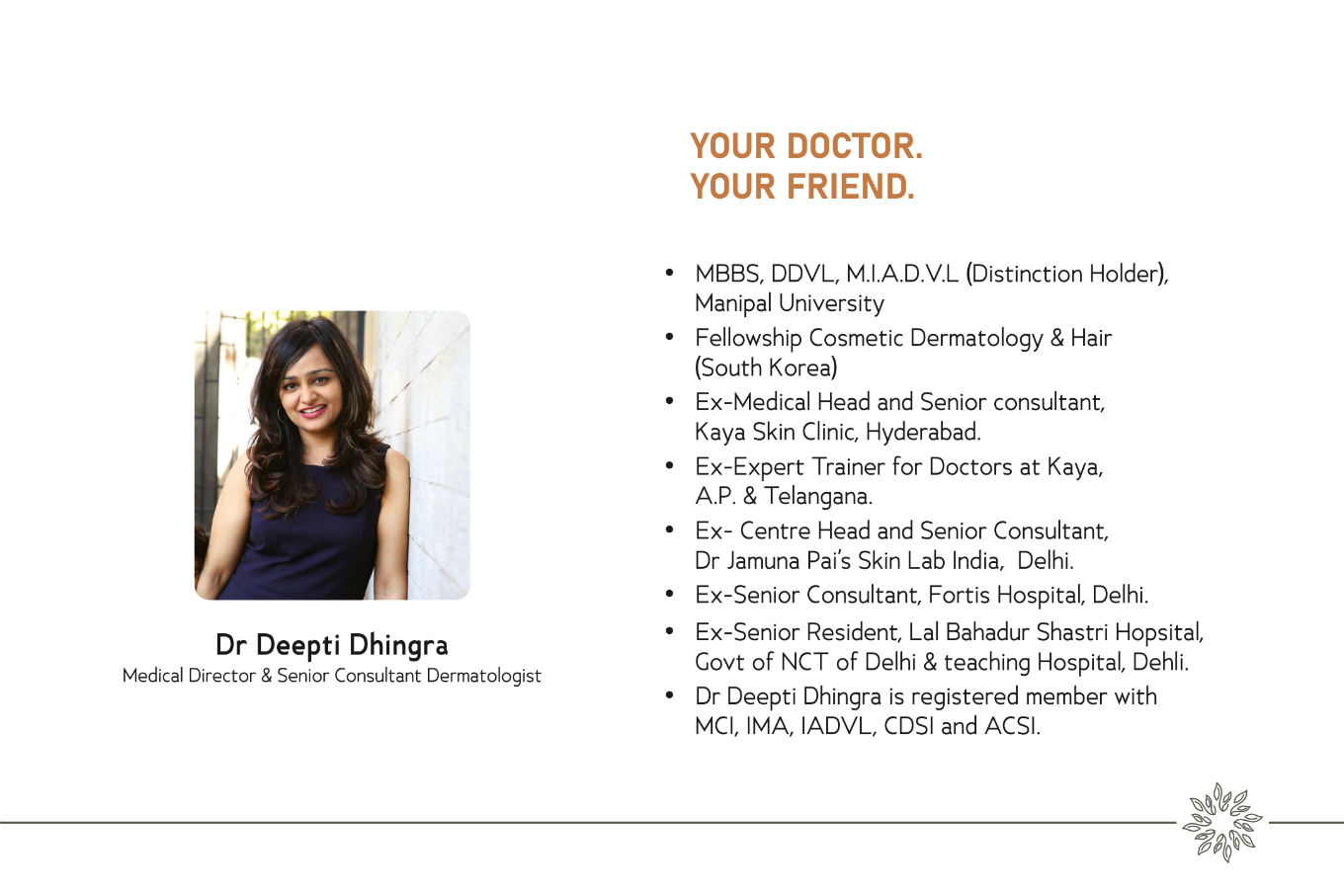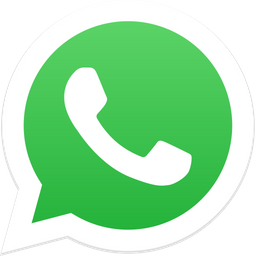You’re in Safe Hands
We are SkinStation that promotes the recovery of people with skin
issues through meaningful work and extensive clinical care.
Urticaria
Hives, also known as urticaria, is a kind of skin rash with red, raised, itchy bumps. They may also burn or sting. Often the patches of rash move around. Typically they last a few days and do not leave any long-lasting skin changes. Fewer than 5% of cases last for more than six weeks. The condition frequently recurs. Hives frequently occur following an infection or as a result of an allergic reaction such as to medication, insect bites, or food. Psychological stress, cold temperature, or vibration .
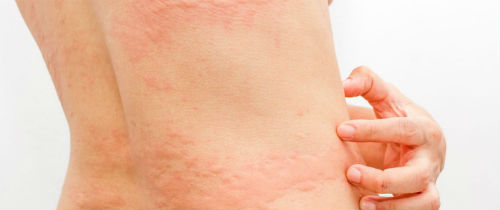
Psoriasis
Psoriasis is a noncontagious, chronic skin disease that produces plaques of thickened, scaly skin. The dry flakes of silvery-white skin scales result from the excessively rapid proliferation of skin cells.. Psoriasis commonly affects the skin of the elbows, knees, and scalp.
Oral and topical medications
EXCIMER LASER TREATMENT -- Excimer laser is an effective technique to treat Vitiligo Psoriasis and alopecia areata . Excimer laser delivers targeted, high-dose, monochromatic therapeutic light with wavelength of 308nm directly to the affected tissue without exposing healthy skin.
The excimer laser creates a concentrated, but painless, beam of ultraviolet light that is delivered to vitiligo patches through a hand piece. By targeting depigmented patches, the laser stimulates repigmentation and limits exposure to healthy skin. Excimer laser therapy is for patients of all ages and ethnic backgrounds.
At Skin station , we offer USFDA Approved Excimer technology which is a breakthrough in treating our patients suffering from the menace
of these disturbing diseases .
Our Doctor will analyse your skin and provide the right dose for treating such areas thus providing relief in these disorders of skin .

Vitiligo
VITILIGO is a long-term skin condition characterized by patches of the skin losing their pigment. The patches of skin affected become white and usually have sharp margins. The hair from the skin may also become white. The inside of the mouth and nose may also be involved. Typically both sides of the body are affected. Often the patches begin on areas of skin that are exposed to the sun. It is more noticeable in people with dark skin. Vitiligo may result in psychological stress and those affected
Oral and topical medications
Excimer laser -- Excimer laser is an effective technique to treat Vitiligo Psoriasis and alopecia areata . Excimer laser delivers targeted, high-dose, monochromatic therapeutic light with wavelength of 308nm directly to the affected tissue without exposing healthy skin.
The excimer laser creates a concentrated, but painless, beam of ultraviolet light that is delivered to vitiligo patches through a hand piece. By targeting depigmented patches, the laser stimulates repigmentation and limits exposure to healthy skin. Excimer laser therapy is for patients of all ages and ethnic backgrounds.
At Skin station , we offer USFDA Approved Excimer technology which is a breakthrough in treating our patients suffering from the menace
of these disturbing diseases .
Our Doctor will analyse your skin and provide the right dose for treating such areas thus providing relief in these disorders of skin .
.jpg)
Eczema /Atopic Dermatitis
Dermatitis, also known as eczema, is a group of diseases that results in inflammation of the skin. These diseases are characterized by itchiness, red skin and a rash. In cases of short duration, there may be small blisters, while in long-term cases the skin may become thickened. The area of skin involved can vary from small to the entire body. Dermatitis is a group of skin conditions that includes atopic dermatitis, allergic contact dermatitis, irritant contact dermatitis and stasis dermatitis.
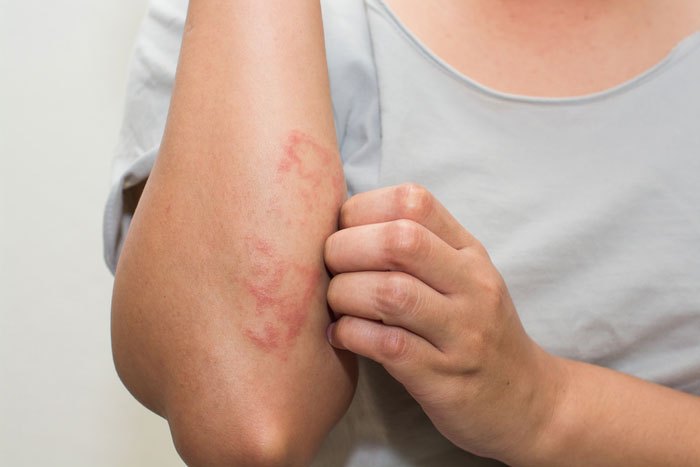
Lichen Planus
Lichen planus is a skin rash triggered by the immune system. It’s not known why the immune response occurs. There may be several contributing factors, and each case is different. Potential causes include:
- viral infections
- allergens
- stress
- genetics
Sometimes lichen planus occurs along with autoimmune disorders. While it may be uncomfortable, in most cases lichen planus is not a serious condition. It’s also not contagious.
Lichen planus is a skin condition of unknown origin that produces small, shiny, flat-topped, itchy pink or purple raised spots on the wrists, forearms or lower legs, especially in middle-aged patients.
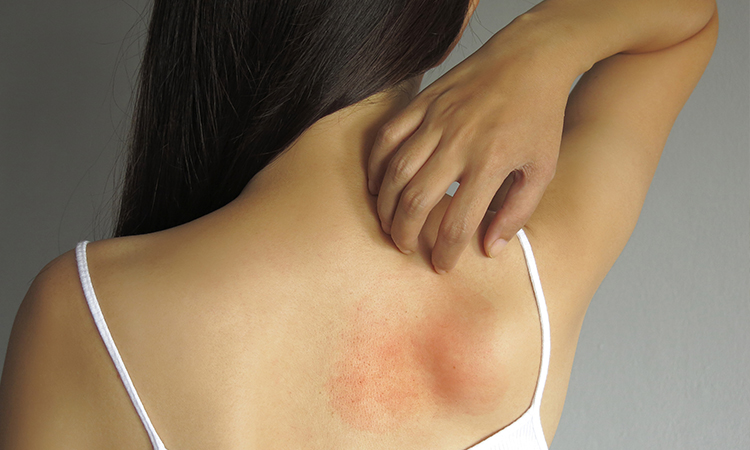
Fungal /Viral /Bacterial Infections
Unsanitary conditions , humidity , sugar levels can lead a person to develop various infectyions of the skin .
Warts , Molluscum contagiosum - Viral infection of the skin resulting in tiny growths over the skin
Radiocautery - This procedure uses radiofrequency waves to perform minor dermato-surgical procedures. It removes and cuts areas with minimal tissue damage and least amount of downtime. It is a quick procedure, with minimal pain. Radiocautery creates a bloodless field so there is no bleeding while removal of these lesion
Skin Tags
Skin outgrowth occurring in skin folds .
Radiocautery - This procedure uses radiofrequency waves to perform minor dermato-surgical procedures. It removes and cuts areas with minimal tissue damage and least amount of downtime. It is a quick procedure, with minimal pain. Radiocautery creates a bloodless field so there is no bleeding while removal of these lesion
Xanthelesma palpebrarum -Yellowish deposits around eyelids in people with increased cholesterol levlkes
Autoimmune disorders and Connective Tissue diseaseslike Systemic Lupus Erythematosus , Dermatomyositis ,etc require a complete medical evaluation and are treated .
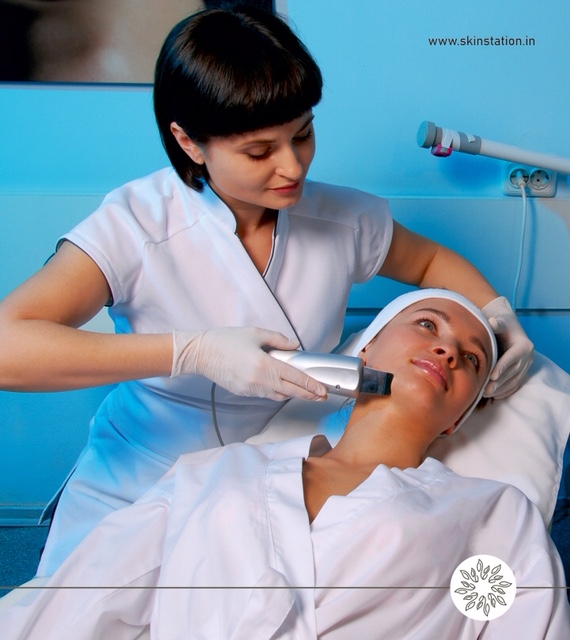
Keloids
Keloids are raised overgrowths of scar tissue that occur at the site of a skin injury. They occur where trauma, surgery, blisters, vaccinations, acne or body piercing have injured the skin
Intralesional Therapy - An intralesional steroid injection involves a corticosteroid such as triamcinolone acetonide injected directly into a lesion on or immediately below the skin. It is a highly effective and safe way to treat issues like keloids , active nodular acne and alopecia areata .
What are the benefits of intralesional steroids?
Intralesional administration of corticosteroids treats a skin disorder directly without entering the bloodstream .
The advantages are :
- Bypass the barrier of the top layers of skin and directly attacks the cause .
- Reduce the chance of surface skin thinning.
- Deliver higher concentrations to the site of the pathology.
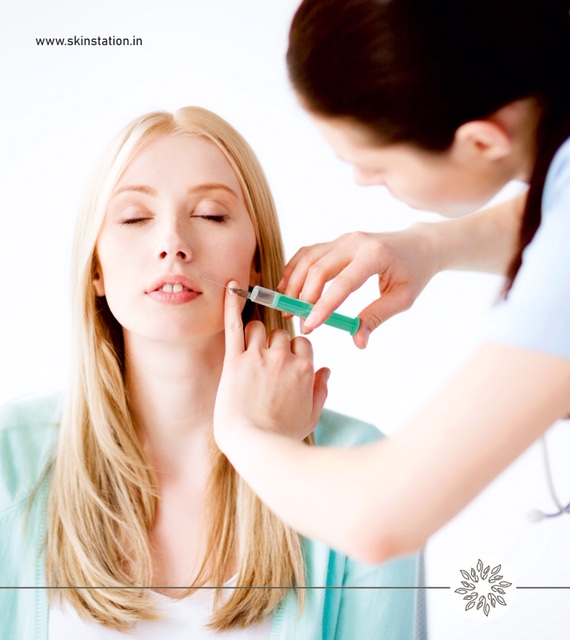
Trichology /Hair
“Natural hair is an exquisite crown .A head full of unique , healthy beauty .”
Common Hair Conditions/Disorders
Excluding common hair problems such as dry, chemically treated/damaged, oily hair and split ends, here are some common hair conditions:
- Hair loss, otherwise known as alopecia, is a common concern for both men and women. Baldness, receding hairlines, bald spots and thinning hair are things we commonly hear when it comes to hair problems:
- Alopecia areata:Total hair loss that occurs in round patches. Cause is usually unknown, but is mostly linked to stress. Hair usually grows back.
- Female pattern baldness:Women experience baldness by way of uniform thinning across the scalp with a preserved hairline.
- Male pattern baldness:This is the most common type of hair loss in men, characterized by a receding hairline, hair loss at the crown, or both.
- Telogen effluvium:Hair fall that abruptly falls out in large patches, typically after a month or two after a personal shock (surgery, childbirth, severe stress, etc).
- Pediculosis capitis (head lice): A common, highly contagious infection that often occurs in children.
- Folliculitis: Inflammation of hair follicles due to a bacterial infection, usually caused by Staphylococcus aureus.
- Piedra: Hair shaft fungal infection that causes hair loss because fungal nodules cling to hair strands.
Oral and topical medications
Platelet rich Plasma therapy - Platelet-rich plasma therapy or (PRP) is gaining popularity as an advanced method for treating patterned hair loss, hair thinning or receding hairline and delivering effective natural hair regrowth results. In this article, we will help you understand more about this procedure, along with its cost and expected results.
Things To Know About PRP Therapy For Hair
- Availability -You can opt for PRP treatment at hair clinics.
- Pain –It is a minimally invasive procedure and is virtually pain-free.
- Risk Factors –The PRP procedure is safe with no side effects like bleeding, allergy, infection, etc.
- Treatment Duration – Trichologists recommend 6-8 sessions at an interval of one month each. Each session lasts from an hour to an hour and a half.
- Tests and Medication – A blood test is necessary, and your dermatologist might prescribe ancillary medication.
- Results – The results are visible after three months of undergoing the first session.
- Ideal Candidate –Anyone suffering from patterned hair loss or androgenetic alopecia can opt for PRP. Your trichologist may recommend it after completing a thorough diagnosis by recording your medical history and conducting a trichoscopy. The minimum age for this treatment is 18 years.
PRP Hair Treatment Procedure
The PRP hair treatment is a four-step process as explained below –
- Collection Of Blood Sample:-As the first step of the PRP hair loss treatment process, your doctor will take a 20 ml blood sample.
- Separation Of Platelets:–Dermatologists use the centrifuge technique for the separation of platelets from the blood. The double spin method ensures the optimal concentration of platelets that are rich in growth factors.
- Extraction and Activation Of PRP From The Blood:–Doctors extract Platelet Rich Plasma (PRP) from the remaining layers of Platelet Poor Plasma (PPP), and red blood cells in the tube. Before injecting the PRP into a patient’s scalp, trichologists activate the growth factors in the plasma using an activating agent.
- Insertion Of PRP Into Affected Area With Injections:– In the last step, dermatologists inject the PRP extracted from the blood safely into the affected area on the scalp with the use of microneedles. Before inserting the platelet-rich plasma, your dermatologist will administer local anaesthesia into the scalp margin, so that you don’t feel any pain.
PRP Hair Treatment Success Rate & Reviews
- Numerous studies worldwide indicate that PRP therapy is one of the most successful non-surgical methods to treat hair loss, thinning hair and pattern baldness. It will increase the duration of the growth phase of hair, reduce hair fall, and reverse thinning to an extent which ultimately helps in improving the scalp coverage by boosting natural hair regrowth. After the initial sessions, you will notice a reduction in hair fall. The result of treatment is evident after the third session as you will start noticing visible hair regrowth.
- Depending on the grade of hair loss and degree of thinning of hair, your dermatologist will decide the number of sessions of PRP you require; and maintenance sessions if any; along with the necessary medical treatment in the form of topical applicants and oral medications etc.
- According to a 2015 study of males with patterned hair loss in Italy, PRP treatment helped in increasing the hair density on target areas of the scalp, and the results were evident after three months. Considering its simplicity, safety, and cost-effectiveness, doctors consider PRP hair treatment a feasible treatment option for patterned hair loss not only in males but females as well, along with the adjuvant medications.
Intra lesional Therapy
An intralesional steroid injection involves a corticosteroid such as triamcinolone acetonide injected directly into a lesion on or immediately below the skin. It is a highly effective and safe way to treat issues like keloids , active nodular acne and alopecia areata .
What are the benefits of intralesional steroids?
Intralesional administration of corticosteroids treats a skin disorder directly without entering the bloodstream .
The advantages are :
- Bypass the barrier of the top layers of skin and directly attacks the cause .
- Reduce the chance of surface skin thinning.
- Deliver higher concentrations to the site of the pathology.
Mesotherapy
Mesotherapy is a non-invasive and non-surgical cosmetic hair restoration procedure which has been steadily gaining in popularity.
Superficial microinjections are inserted just below the epidermal layer of the skin into the appropriate tissues to stimulate the mesoderm layer in the skin, which lies at a depth of about
1mm beneath the surface, in order encourage the hair’s natural regeneration and proliferation process.
Mesotherapy treatment has now been used for decades to successfully restore luster and volume to thinning hair and to promote significant hair regrowth for both women and men who have experienced the beginnings of balding or Alopecia Areata.
The technology at the root of the treatment is based on the understanding that most hair loss problems are a result of lack of proper nutrients, reduced blood circulation to the scalp, and hormone imbalances around the hair follicle, in particular an excess production of the hair loss androgen DHT.
For hair restoration treatments, the Mesotherapy solution injected into the scalp contains a special combination of specific chemicals, minerals, amino acids, vitamins, nucleic acids and co-enzymes specifically tailored according to the patient’s unique requirements.
The treatment restores hormone balance at a gradual pace, which enables the steady growth of new, healthy hair strands.
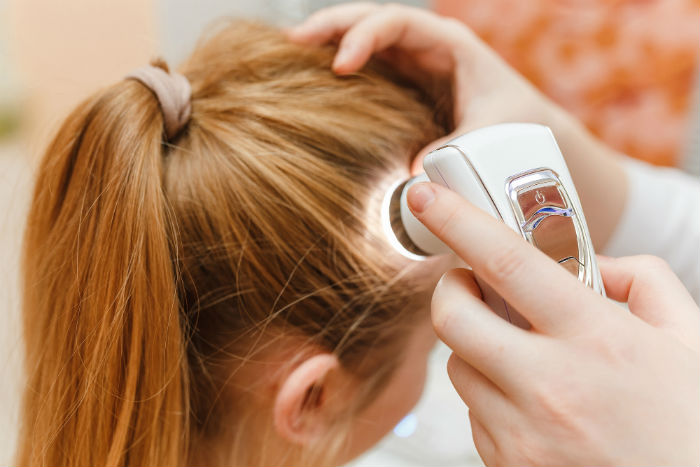
Unwanted Facial / Body Hair
Laser Hair Removal is a highly effective and proven method to remove unwanted hair on the body and face. Suitable for all skin types, an average of six to ten treatments are needed, one every four to six weeks, to destroy the hair follicles beneath the skin and prevent hair growth. Laser hair removal is a great alternative to traditional methods such as waxing, shaving and threading, ultimately saving you time and money.
Why should I have laser hair removal?
Laser hair removal requires a short term commitment to get long term results. of Results aren’t instantaneous but once your course of treatments has been completed, you will not have to think about regular hair removal again
- Once it’s gone, it’s gone! No in-grown hairs, stubble or razor rash
- Long-term cost saving against traditional methods
What will happen at my first laser hair removal appointment?
- During your consultation, we will assess the areas you wish to have treated. This means we’ll need a small amount of hair growth to be visible. Using this information, we will then discuss the number of treatments and the intervals needed between sessions, before carrying out a test on the area.
- We will start this test by shaving the hairs in the area to be treated because this allows the laser energy to be absorbed deeper into the skin at the root of the hair. We will often test multiple laser settings to establish the best results for your skin and hair type.
- Your first laser hair removal session can take place at least 24 hours after your test patch has been completed. To prepare, you will shave at home first before we perform the treatment, apply aftercare and discuss the aftercare process with you before scheduling your next appointment. The best results are achieved with regular treatments due to the hair growth phases mentioned above.
- After each treatment, the hair growth will slow down and it will usually take approximately 2 weeks for the hairs to fall out. Your next appointment will be booked in for around 6 weeks later when some hairs have regrown. With each treatment session, fewer and fewer hairs will grow back and take longer to show. This means we can gradually space the treatments further apart.
How does laser hair removal work?
- First, let’s talk about the hair itself. All face and body hair goes through 3 distinct phases of growth: Anagen, Catagen & Telogen. The Anagen phase is most effective for laser hair reduction results beacuse this is when the hair is still attached to the blood supply and is fully pigmented. Approximately 20% of hairs on the body are in the anagen phase at any time, which is why you will need a course of treatments to get the best results.
- So how does the laser itself work to effectively remove hair? Here’s a question – have you ever noticed how dark clothes absorb sunlight and heat up on a hot day? That’s how laser hair removal works – the pigment (colour) in your hair follicles absorbs the heat from the laser, which then heats the follicle, causing destruction of the blood supply and follicle cells. This, ultimately, discourages further hair growth.
- The hairs need to have some colour to them to be treated with a laser, so darker and thicker hairs respond best to this treatment.
How many laser hair removal treatments will I need?
Multiple treatments are needed (between six and ten) because only the hair in the active growth phase – the Anagen phase – can be affected by the laser. Time is needed for hairs in the Catagen and Telogen phases to move into the Anagen phase. Effective results require treatments spread evenly and consistently, from four to eight weeks, depending on the face or body area.
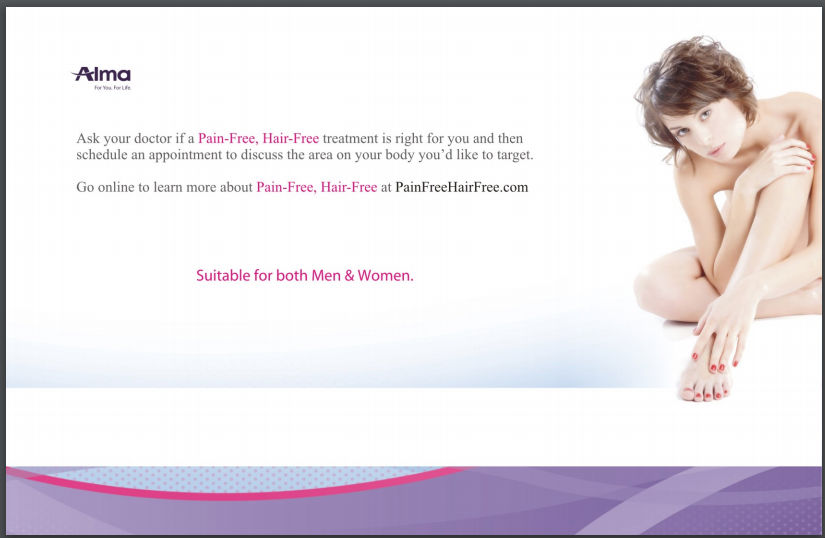
Acne Vulgaris
A skin condition that occurs when hair follicles plug with oil and dead skin cells.
- Very common
- More than 10 million cases per year (India)
- Treatable by a medical professional
- Requires a medical diagnosis
- Lab tests or imaging not required
- Acne is most common in teenagers and young adults.
- Symptoms range from uninflamed blackheads to pus-filled pimples or large, red and tender bumps.
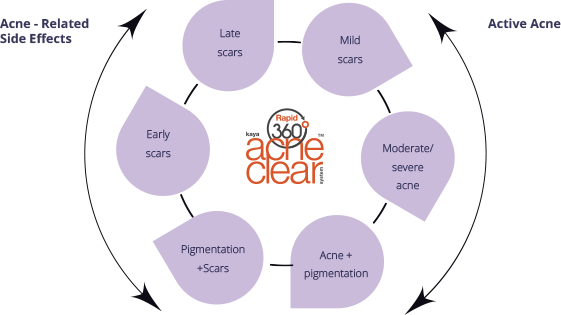
PEELS
What is chemical peel?
A chemical peel is an acidic solution, which is applied to the affected parts of your skin. On penetrating the skin, the solution destroys dead skin, unclogs pores and makes way for new skin to regenerate. The acne blemishes and scars disappear. There are three basic types of peels:
- Superficial Peels: which is a mild peel and can be used on all skin types.
- Medium Peels: can penetrate a little deeper into your skin. Medium peels are also known to cause second degree burns on the skin.
- Deep Peels: penetrate further into the deeper layers of the skin and are also known to cause second-degree burns. A deep peel is not suitable for people with dark skin tone as it can lead to hypopigmentation. A deep peel can be performed only once.
What happens during a chemical peel procedure?
The chemical peel process is quite simple:
- At the outset, the doctor cleanses your skin.
- He/she then applies the solution comprising the chemical peel on your skin, using a soft brush.
- The solution is left on your skin for approximately 10 minutes.
- Thereafter, the doctor applies a neutralizer on your skin to end the chemical reaction of the solution on your skin.
- Application of the neutralizer is followed by a cold compress, which is applied to reduce the discomfort on your skin. (A hand-held fan may also be used to minimize the burning feeling on your skin.)
- The doctor then applies a cream or a mask on your skin again and leaves it on your face for a few minutes.
- Finally, the doctor cleanses your skin.
The duration of the entire process is around 20-30 minutes.
Will the chemical peel suit my skin type?
There are various types of chemical peels available, such as Salicylic Acid peel, Glycolic Acid Peel, TCA (Trichloroacetic acid) Peel, Phenol Peel
and Fruit Acid Peel.
The chemical peel most suitable for you is determined on the basis of your skin texture, type, problems, and many other similar aspects.
Peels available at Skin Station
Alpha Hydroxy Acid Peels
Alpha hydroxy acids, also known as AHAs, are one of the most popular ingredients in a mild chemical peel. Glycolic acid is the most common AHA used for this purpose. AHA peels rarely need any sort of anesthetic to perform, and the discomfort during and after the procedure is minimal. This peel is typically used to reduce the appearance of fine lines, smooth rough skin and produce a more even skin tone. Because this is a mild chemical peel, a series of treatments may be required to achieve desired results.
Beta Hydroxy Acid Peels
The most common beta hydroxy acid used in chemical peels is salicylic acid. This substance is also frequently used in acne products, which is why salicylic chemical peels are often used to treat acne-prone skin. Salicylic acid is more potent than glycolic acid, so it provides a slightly deeper chemical peel with longer lasting results. Because beta hydroxy acid chemical peels are also considered mild resurfacing treatments, no anesthesia is needed and the recovery time after the procedure is relatively short. However, it may take more than one treatment session to achieve desired results, and the procedure will need to be repeated periodically to maintain softer, smoother skin.The most common beta hydroxy acid used in chemical peels is salicylic acid. This substance is also frequently used in acne products, which is why salicylic chemical peels are often used to treat acne-prone skin. Salicylic acid is more potent than glycolic acid, so it provides a slightly deeper chemical peel with longer lasting results. Because beta hydroxy acid chemical peels are also considered mild resurfacing treatments, no anesthesia is needed and the recovery time after the procedure is relatively short. However, it may take more than one treatment session to achieve desired results, and the procedure will need to be repeated periodically to maintain softer, smoother skin.
Jessner's Peel
Jessner's peel is actually a combination of ingredients mixed into a single formula. It is considered a light chemical peel that is slightly stronger than both the alpha and beta hydroxy formulas. Jessner's peel uses lactic acid, salicylic acid and resorcinol, which is also sometimes used as a disinfectant or acne medication. It is applied to skin that is too damaged to respond well to an AHA peel, but does not require a medium to deep treatment. Jessner's peels are often applied without the use of anesthetic and complete recovery after the treatment takes about a week.
TCA Peels
Trichloroacetic acid is the most common ingredient found in medium chemical peels. This substance can successfully treat a host of skin imperfections, including sun damage, fine lines and wrinkles, and acne scarring. The procedure offers effective results with minimum risk. Most patients do not require anesthesia during the procedure, although over the counter pain medications may be needed for a day or two afterward to reduce the stinging sensation that can sometimes occur. TCA chemical peels usually take about a week to recover from, and the results are much more dramatic than lighter peels can offer. Some patients need more than one treatment session to achieve desired results.
NATURAL SKIN REJUVENATION and ACNE TREATMENT WITH PRP
WHAT IS PRP?
Platelet rich plasma (PRP) is concentrated blood plasma that contains approximately 3 to 5 times the number of platelets found in normal circulating blood. In addition, it contains platelet-derived growth factor (PDGF), vascular endothelial growth factor (VEGF), transforming growth factor (TGF) and other bioactive proteins that help in the rejuvenation of skin.
PRP is a facial rejuvenation treatment that uses your own plasma to stimulate collagen production and cell migration, allowing for the elimination of lines, folds, and wrinkles. Results from PRP therapy are natural looking and subtle, and they can last for as long as two years. What’s more, PRP is minimally invasive, has no risk of allergic reaction, and can be used to treat nearly any area of the body without risks of side-effects, making it ideal for patients who are not interested in or are not good candidates for injectable fillers.
HOW DOES PRP TREAT THE ACNE ?
The body cells which aid the tissue in healing and producing new cells are called Platelets. PRP is injected into targeted areas of the skin and then forms an environment which helps in growing collagen, regenerates the tissues which helps in treating the acne and heals the skin withpout leaving any marks or scars
RESULTS FOR PRP SKIN TREATMENT
It is ideal to undergo three treatments with a gap of four to six weeks in order to get the maximum output of PRP skin rejuvenation treatment.
Post treatment, the first effect will appear in the first month when you will experience the improvement in the active acne .
The skin starts to look healthy and even the scars appearance reduces significantly due to collagen build up.
BENEFITS OF PRP SKIN REJUVENATION TREATMENT
- Non-Invasive :PRP is a non-surgical process. The platelet-rich plasma extracted from the patient’s blood sample is simply injected into the area to be treated with a small needle.
- Quick :Since it’s a non-invasive process, PRP treatments can sometimes take, as less as 30 minutes. Once the platelet-rich plasma is activated, it mimics an injury response in the body. Healing and growth factors work to remodel the epidermis and enhance the texture and appearance of the skin. As the body begins to produce natural collagen in the affected area, results are noticed within the first few weeks following the first treatment, and the skin’s appearance continues to improve over time.
- Long Lasting :The process is quick, but the result is just the opposite. For optimal results, three or four treatments may be recommended, after which the benefits will continue to be visible for up to 18 months or more.
- All Natural :Your body naturally produces the ingredients necessary to rejuvenate your skin. Every treatment is formulated using blood from the patient’s own body. This means there is no chance of allergic reaction, infection, or rejection of the treatment– the same can’t be said of synthetic fillers.
VAMPIRE FACELIFT VS PRP TREATMENT
A cosmetic procedure is available to patients who want to surgically reposition the facial tissues that have loosened over time. The Vampire Facelift uses injections of the patient’s own blood through a technology known as Selphyl. This procedure involves extracting blood from your arm and then spinning the blood sample in a centrifuge to separate the platelets. The blood cells are then re-injected into the skin with a very fine needle, and only injected into the areas that need to be filled out or restored. These injections are performed in conjunction with fat injections to create a smooth, rounder and plumper appearance. The term Vampire Facelift™ was trademarked by an Alabama-based physician, Dr. Charles Runnels. A Vampire Facelift™ is a combination treatment that incorporates PRP with the appropriate hyaluronic acid injectable fillers based on the patient’s specific needs to produce the most optimal results. The combination of hyaluronic acid fillers and PRP can address even deeper folds and wrinkles, producing a softer and significantly more youthful appearance that can last for 9-12 months. This option is often best for men and women who have more pronounced signs of aging due to smoking, excessive sun exposure, and other environmental and genetic factors.
QSWITCH LASER
Can the Q-switch laser be the solution to your acne?
Struggling with acne marks and other pigmentation issues? You may be a good candidate for a Q-switched laser treatment. While this sounds like a weird weapon in a science fiction movie, it’s actually one of the beauty industry’s favorite tools for addressing not just acne, but tattoo removal and overall skin rejuvenation. Skin treatment Singapore experts from The Clifford Clinic answer your Q’s on the Q-switch.
How does the Q-switch laser work?
Lasers are a concentrated beams of energy that can help break down cells. Pigmented cells are more likely to absorb its energy – and then break down
from the heat – so these are very effective in skin problems that involve discoloration: acne marks, freckles, sun spots, and age spots. Lasers can
break down the colored pigments in tattoos, or target skin darkening to achieve a fairer complexion.
Lasers usually work at the wavelength of 1064nm, but doctors can set the level and frequency of the laser that’s suitable for your skin concern.
Why is the Q-switch laser effective for acne?
This powerful laser energy breaks down the pigments in acne marks, and can even help prevent breakout. It killls the P-acne bacteria, and can shrink
the skin’s oil glands. Note that it’s not the skin’s oil that causes breakouts. The real issue is when the pores are clogged with sebum and dead skin
cells. However, controlling excess oil production can lower your risk for acne especially when paired with an effective everyday cleansing regimen.
There is also research that pimple and acne breakouts tend to be less severe and inflamed after a laser treatment. While this depends on your own case history – how often you get breakouts,
what kind of breakouts you get, and the cause – Q-switch laser can play an important role in pro-active acne control.
What can you expect from a Q-switch laser?
Results depends on the severity of the acne marks or scars, but you can expect up to 90% improvement of discoloration. Your doctor can discuss how many sessions you may need especially In the case of deeper, darker acne marks and scars.
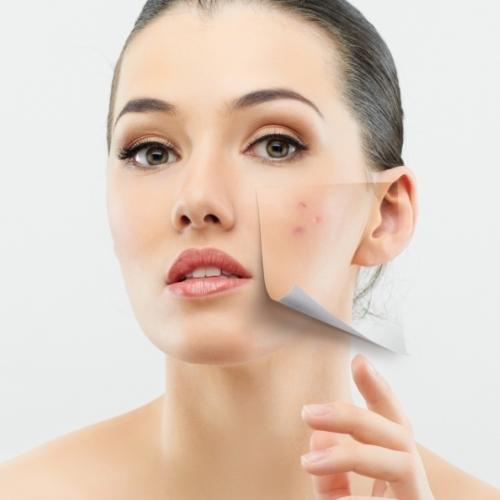
Acne Scars / Traumatic scars / Burn Scars /Accidental Scars
A scar is a mark left on the skin after a wound or injury has healed.
Scars are a natural part of the healing process. Most will fade and become paler over time, although they never completely disappear.
Types of scars
A scar can be a fine line or a pitted hole on the skin, or an abnormal overgrowth of tissue.
Normal fine-line scars
A minor wound like a cut will usually heal to leave a red, raised line, which will gradually get paler and flatter over time. This process can take up to two years. The scar won't disappear completely and you'll be left with a visible mark or line. Fine-line scars are common following a wound or after surgery. They aren't usually painful, but they may be itchy for a few months. On darker skin types, the scar tissue may fade to leave a brown or white mark. A pale scar may be more obvious on tanned skin because scar tissue doesn't tan.
Pitted or sunken scars
Some scars caused by skin conditions, such as acne and chickenpox, can have a sunken or pitted appearance. Pitted scars, also known as atrophic or "ice-pick" scars, can also occur as a result of an injury that causes a loss of underlying fat.
Scar contractures
Scar contractures are often caused by burns. They occur when the skin "shrinks", leading to tightness and a restriction in movement.
Treating scars
Complete scar removal isn't possible, but most scars will gradually fade and become paler over time.
A number of treatments are available that may improve a scar's appearance and help make it less visible.
Although scars are permanent, they can fade over a period of up to two years. It's unlikely they'll fade any more after this time.
If scarring is unsightly, uncomfortable or restrictive, treatment options may include:
LASERS
The he ResurFX™ fractional laser is a state-of-the-art, non-ablative, skin resurfacing technology. ResurFX™ fractional laser stimulates the production of new collagen and elastic fibers in the deeper layers of the skin.
What Should I Expect?
When Will I See Results?
The Lumenis® ResurFX™ treatment works with your skin to stimulate deep collagen regeneration over a sequence of treatments. Typically, about 3 sessions are needed to have visible improvement in the skin texture. But, already after the first treatment, you may notice changes in pores dimensions.
Typically, results are achieved after 3-5 sessions in 4-5 weeks intervals. However, you may continue to see improvements for up to six months following the treatment.
MICRONEEDLING
What Should I Expect?
Microneedling is a type of treatment that uses small needles to cause tiny punctures in the skin. These small contact points encourage the body to create a wound healing response and renew the skin cells. As your skin repairs, the production of collagen and elastin is triggered to give an almost immediate plumping effect. It can also help tackle other skin damage such as scar
Which Microneedling treatment is right for you?
Here at Skinstation we perform several types of Microneedling.
Dermaroller – is a titanium device that is rolled over the skin to create thousands of tiny contact points. This causes the body to create a wound healing process for rejuvenated, smoother and younger looking skin.
Does Microneedling Hurt?
A topical numbing cream is applied to the area before carrying out Microneedling treatments to ensure any pain is minimised. Variable treatment intensities allow us to further control the comfort of the treatment. No topical anaesthetic is needed for Microneedling Pen Revitalise & Rejuvenate as the treatment isn’t deep enough to cause any discomfort.
NATURAL SKIN REJUVENATION WITH PRP
WHAT IS PRP?
Platelet rich plasma (PRP) is concentrated blood plasma that contains approximately 3 to 5 times the number of platelets found in normal circulating
blood. In addition, it contains platelet-derived growth factor (PDGF), vascular endothelial growth factor (VEGF), transforming growth factor (TGF) and other
bioactive proteins that help in the rejuvenation of skin.
PRP is a facial rejuvenation treatment that uses your own plasma to stimulate collagen production and cell migration, allowing for the elimination of lines, folds, and wrinkles. Results from PRP
therapy are natural looking and subtle, and they can last for as long as two years. What’s more, PRP is minimally invasive, has no risk of allergic reaction, and can be used to treat nearly any area
of the body without risks of side-effects, making it ideal for patients who are not interested in or are not good candidates for injectable fillers.
HOW DOES PRP WORK ON SCARS ?
The body cells which aid the tissue in healing and producing new cells are called Platelets. PRP is injected into targeted areas of the skin and then forms an environment which helps in growing collagen, regenerates the tissues and makes your skin smooth and tight. PRP softens wrinkles and creates skin texture and tone that is smoother, younger and better. Since it builds collagen it is able to reduce the scars effectively . It can be used in conjungtion with the dermarollers and microneedling to reduce the appearance of scars .
Stretch marks
Stretch marks are narrow streaks or lines that appear on the skin's surface when the deeper layer of skin (dermis) tears. They're often caused by hormonal changes that occur during pregnancy or puberty, or as a result of bodybuilding or hormone replacement therapy.
Treatment
Microneedling
Microneedling is a type of treatment that uses small needles to cause tiny punctures in the skin. These small contact points encourage the body to create a wound healing response and renew the skin cells. As your skin repairs, the production of collagen and elastin is triggered to give an almost immediate plumping effect. A Microneedling device like a dermaroller can work effectively alone or in combination with collagen build up procedures like PRP to reduce the appearance of stretch marks .
STRETCH MARK REDUCTION WITH PRP
WHAT IS PRP?
Platelet rich plasma (PRP) is concentrated blood plasma that contains approximately 3 to 5 times the number of platelets found in normal circulating blood. In addition, it contains platelet-derived growth factor (PDGF), vascular endothelial growth factor (VEGF), transforming growth factor (TGF) and other bioactive proteins that help in the rejuvenation of skin. PRP is a facial rejuvenation treatment that uses your own plasma to stimulate collagen production and cell migration, allowing for the elimination of lines, folds, and wrinkles. Results from PRP therapy are natural looking and subtle, and they can last for as long as two years. What’s more, PRP is minimally invasive, has no risk of allergic reaction, and can be used to treat nearly any area of the body without risks of side-effects, making it ideal for patients who are not interested in or are not good candidates for injectable fillers.
HOW DOES PRP REJUVENATE THE SKIN?
The body cells which aid the tissue in healing and producing new cells are called Platelets. PRP is injected into targeted areas of the skin and then forms an environment which helps in growing collagen, regenerates the tissues and makes your skin smooth and tight. PRP thus helps in reducing the appearance of stretch marks . It can be used in combination with other technologies to reduce stretch marks .
Laser
ResurFX is a good choice in order to safely and effectively minimize the appearance of unwanted stretch marks on the body. The number of treatments needed will depend on the size of the treatment area and severity of the stretch marks, but most patients see noticeable results after 3-4 session
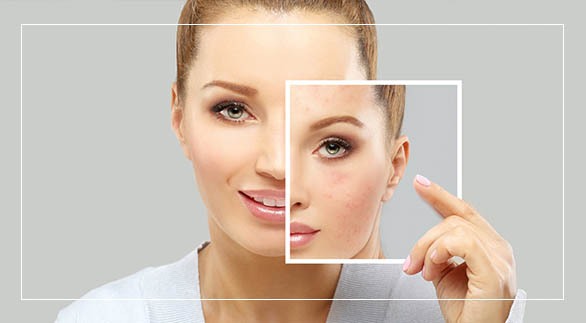
Hyper Pigmentation
Excess of melanin (pigment) deposition is always undesirable and the need to treat it immediately arises. Pigmentation can be superficial- restricted to the epidermis (brown) or deep – Dermal (blue-black). These conditions are usually unrelated to our well being but aesthetically are a cause of great concern.
Pigmentation can occur for a number of reasons:
- Melasma which is usually hormonal
- Post pregnancy
- Becker’s naevus
- Excessive exposure to sunlight – Sun spots
- Freckles
- Acanthosis nigricans
- Deep dermal pigmentation
- Use of wrong cosmetic products
- Post trauma or injury
- Post acne eruptions
- Hereditary
- Drug induced
It is important to diagnose the underlying cause and treat pigmentary conditions with great caution as they do have tendencies to flare and worsen. At the treatments are uniquely designed according to the concerns.
Treatment
Chemical peels
What is chemical peel?
A chemical peel is an acidic solution, which is applied to the affected parts of your skin. On penetrating the skin, the solution destroys dead skin, unclogs pores and makes way for new skin to regenerate. The acne blemishes and scars disappear. There are three basic types of peels:
- Superficial Peels: which is a mild peel and can be used on all skin types.
- Medium Peels: can penetrate a little deeper into your skin. Medium peels are also known to cause second degree burns on the skin.
- Deep Peels: penetrate further into the deeper layers of the skin and are also known to cause second-degree burns. A deep peel is not suitable for people with dark skin tone as it can lead to hypopigmentation. A deep peel can be performed only once.
What happens during a chemical peel procedure?
The chemical peel process is quite simple:
- At the outset, the doctor cleanses your skin.
- He/she then applies the solution comprising the chemical peel on your skin, using a soft brush.
- The solution is left on your skin for approximately 10 minutes.
- Thereafter, the doctor applies a neutralizer on your skin to end the chemical reaction of the solution on your skin.
- Application of the neutralizer is followed by a cold compress, which is applied to reduce the discomfort on your skin. (A hand-held fan may also be used to minimize the burning feeling on your skin.)
- The doctor then applies a cream or a mask on your skin again and leaves it on your face for a few minutes.
- Finally, the doctor cleanses your skin.
The duration of the entire process is around 20-30 minutes.
Will the chemical peel suit my skin type?
There are various types of chemical peels available, such as Salicylic Acid peel, Glycolic Acid Peel, TCA (Trichloroacetic acid) Peel, Phenol Peel
and Fruit Acid Peel.
The chemical peel most suitable for you is determined on the basis of your skin texture, type, problems, and many other similar aspects.
Peels available at Skin Station
Alpha Hydroxy Acid Peels
Alpha hydroxy acids, also known as AHAs, are one of the most popular ingredients in a mild chemical peel. Glycolic acid is the most common AHA used for this purpose. AHA peels rarely need any sort of anesthetic to perform, and the discomfort during and after the procedure is minimal. This peel is typically used to reduce the appearance of fine lines, smooth rough skin and produce a more even skin tone. Because this is a mild chemical peel, a series of treatments may be required to achieve desired results.
Beta Hydroxy Acid Peels
The most common beta hydroxy acid used in chemical peels is salicylic acid. This substance is also frequently used in acne products, which is why salicylic chemical peels are often used to treat acne-prone skin. Salicylic acid is more potent than glycolic acid, so it provides a slightly deeper chemical peel with longer lasting results. Because beta hydroxy acid chemical peels are also considered mild resurfacing treatments, no anesthesia is needed and the recovery time after the procedure is relatively short. However, it may take more than one treatment session to achieve desired results, and the procedure will need to be repeated periodically to maintain softer, smoother skin.The most common beta hydroxy acid used in chemical peels is salicylic acid. This substance is also frequently used in acne products, which is why salicylic chemical peels are often used to treat acne-prone skin. Salicylic acid is more potent than glycolic acid, so it provides a slightly deeper chemical peel with longer lasting results. Because beta hydroxy acid chemical peels are also considered mild resurfacing treatments, no anesthesia is needed and the recovery time after the procedure is relatively short. However, it may take more than one treatment session to achieve desired results, and the procedure will need to be repeated periodically to maintain softer, smoother skin.
Jessner's Peel
Jessner's peel is actually a combination of ingredients mixed into a single formula. It is considered a light chemical peel that is slightly stronger than both the alpha and beta hydroxy formulas. Jessner's peel uses lactic acid, salicylic acid and resorcinol, which is also sometimes used as a disinfectant or acne medication. It is applied to skin that is too damaged to respond well to an AHA peel, but does not require a medium to deep treatment. Jessner's peels are often applied without the use of anesthetic and complete recovery after the treatment takes about a week.
TCA Peels
Trichloroacetic acid is the most common ingredient found in medium chemical peels. This substance can successfully treat a host of skin imperfections, including sun damage, fine lines and wrinkles, and acne scarring. The procedure offers effective results with minimum risk. Most patients do not require anesthesia during the procedure, although over the counter pain medications may be needed for a day or two afterward to reduce the stinging sensation that can sometimes occur. TCA chemical peels usually take about a week to recover from, and the results are much more dramatic than lighter peels can offer. Some patients need more than one treatment session to achieve desired results.
Q Switch Laser /Laser Toning
(Q Switched Laser) is the latest technology to treat uneven skin tone and hyper-pigmentation. It is a revolutionary service that uses a Q-Switched laser that is highly safe for Indian skin to treat unwanted pigmentation on skin. Q -Switch laser creates an invisible beam of light that specifically targets the brown pigment or melanin present in the dark spots without having any affect on the surrounding skin. The pigment absorbs the laser energy and gets fragmented within the skin's tissues, thereby giving you smooth and even skin tone. The laser reaches hard to reach deeper areas where products or peels etc do not reach.It usually takes about 6-8 sessions for the service to work effectively. It's a no down-time service and you may return to work or play immediately after.THE Q SWITCH LASER when combined with our highly efficacious skin care products, lightens, stimulates and protects your skin, to help give you a smooth, flawless complexion that you've always desired.

Open pores
Open pores are the dilated opening of oil glands concentrated mainly on T-zone and surrounding cheeks. They occur because of unchecked oil secretions at the younger age and get worse when your skin gets lax in old age
TREATMENT
There are multiple options available with the dermatologists today to minimise open pores. However, studies regarding the effectiveness and response rate are still lacking. The treatment options to minimise open pores include:
Salicylic Acid:
Beta-hydroxy acid like salicylic can seep into the opening of sebaceous ducts and remove the keratin plug; thus help in reducing your open pores. Currently, many OTC face wash and toners with salicylic acid are available in the market as discussed earlier in this article. You can also consider fortnightly salicylic acid peels from the dermatologist, which is an excellent way to control oil secretions and decrease open pores.
Retinoids:
Topical and oral retinoids help in reducing oil secretions and open pores. They are available both OTC and by prescription; later might be more effective.
Lasers:
There are a couple of lasers which might be effective in reducing open pores. These lasers induce collagen remodelling and have been used effectively in reducing bigger pits and craters on the skin caused by acne scars; however, its efficacy in open pores is still to be explored.
TCA CROSS:
It is a simple but effective method to reduce large open pores; however, it has a downtime of 7-10 days. The procedure comprises of application of tri-chloro-acetic acid on the wall of open pores with a toothpick leading to the formation of the black scab on each of treated pores which fall off in 7-10 days. Results are good with 30-50% reduction in the size of pores, and repeated sessions can be done if required.
Derma-rollers:
These might help in reducing open pores by collagen remodelling but are less effective than LASERS.
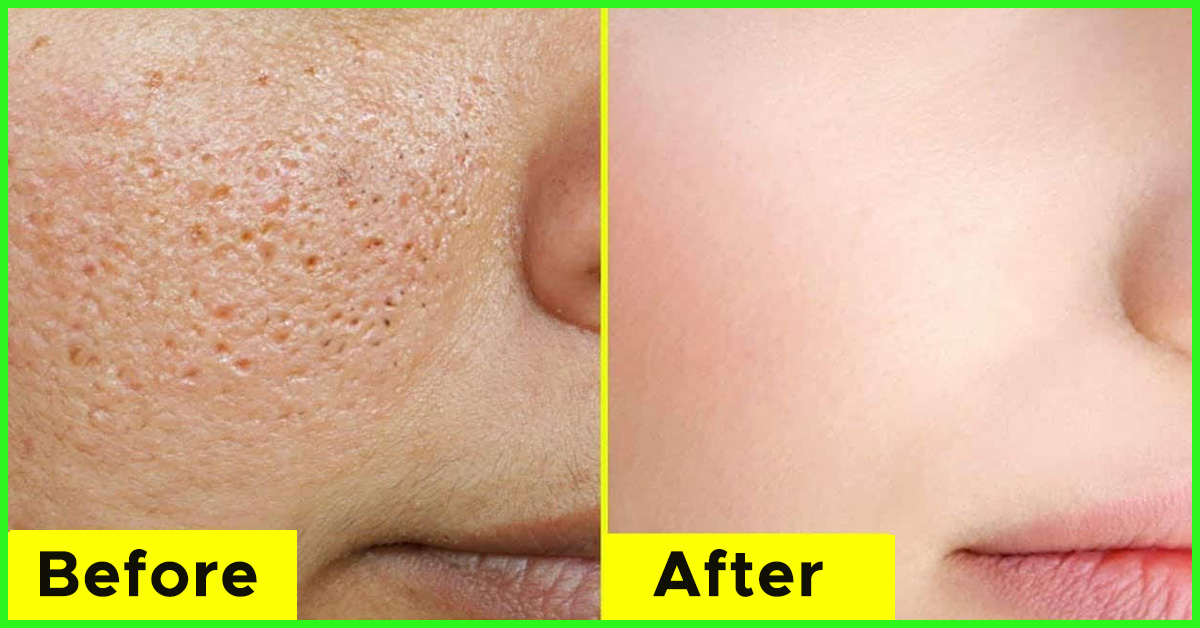
Under Eye Circles
Periorbital dark circles are dark blemishes around the eyes and make a person look extremely tired and fatigued . There are many causes of this symptom, including heredity and bruising.
Common causes of dark circles include :
Allergies, asthma, and eczema
Any condition that causes the eyes to itch can contribute to darker circles due to rubbing or scratching the skin around them. Hay fever sufferers in particular will notice under-eye "smudges" during the height of the allergy season.
Medications
Any medications that cause blood vessels to dilate can cause circles under the eyes to darken. Because the skin under the eyes is very delicate, any increased blood flow shows through the skin.
Anemia
The lack of nutrients in the diet, or the lack of a balanced diet, can contribute to the discoloration of the area under the eyes. It is believed that iron deficiency can cause dark circles as well. Iron deficiency is the most common type of anemia and this condition is a sign that not enough oxygen is getting to the body tissues. The skin can also become more pale during pregnancy and menstruation (due to lack of iron), allowing the underlying veins under the eyes to become more visible.
Fatigue
A lack of sleep and mental fatigue can cause paleness of the skin, allowing the blood underneath the skin to become more visible and appear more blue or darker.
Treatment
Chemical peels for under eye circles
The latest, effective and soothing peel for dark circles is argi peel which contains Arginine, lactic acid, allantoin and aloevera. Arginine is an amino acid derived from brown sugar which boosts collagen, increases elasticity, and moisturises skin. Lactic acid is a mild AHA, which exfoliates and lightens skin, allantoin and aloevera help in skin soothing and regeneration. This is used in conjunction with Vitaman C that provides firmness, resistance and elasticity to the fragile skin of the contour eye area.
Tear trough Fillers
Dermal fillers which are made of hyaluronic acid are injected directly under the hollow of the under eye between the lower eyelid and cheek, effectively lifting the tear trough up. The tear trough filler smooths the appearance of the area, helping to lighten dark circles and erase hallows under the eyes
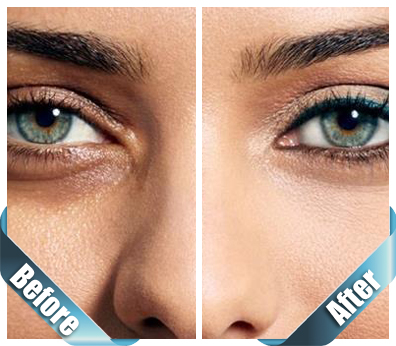
Rosacea /Flushed /Red Skin
Rosacea is a long-term skin condition that typically affects the face. It results in redness, pimples, swelling, and small and superficial dilated
blood vessels. Often, the nose, cheeks, forehead, and chin are most involved. A red, enlarged nose may occur in severe disease, a condition known as
rhinophyma.
Factors that may potentially worsen the condition include heat, exercise, sunlight, cold, spicy food, alcohol, menopause, psychological stress, or steroid cream on the face.
Treatment
Medical facials
Facials for clients with rosacea are soothing services using products aimed at calming irritation and decreasing the appearance of redness associated with this skin condition. Facials for rosacea are designed to protect, correct, and boost the skin by strengthening delicate capillaries and evening skin tone.
Q switch laser
The treatment involves using a handheld medical grade laser device (Qswitch ND-YAG) which is moved back and forth across the skin on the face.
There is a gentle warming sensation. The heat from the laser stimulates collagen regrowth and dilates the capillaries which help to calm the redness and
reduce swelling and itching.
The Qswitch ND-YAG laser effectively:
- Reduces inflammation
- Removes blood vessels
- Destroys bacteria causing pimples and cysts
- Repairs scarring
- Improves the general health of the skin
- Prevents further complications like skin thickening.
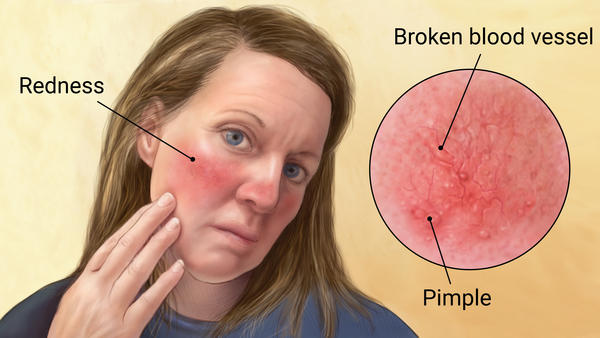
Tan
The skin in response to excess ultraviolet exposure produces melanin which is called as TAN and causes darkening of the skin .
Treatment
Medical facials
To have that radiant and youthful-looking skin, sometimes it all boils down to the basics. It cannot be emphasized enough how important it is to maintain and follow a good skincare routine at home, which includes cleansing, exfoliation and moisturization. However, once in a while, your skin needs an extra dose of pampering that only a medical facial can provide. This is important for rejuvenating and in keeping your skin balanced. Not only is it a good stress reliever, but medical facials also work in clearing out impurities that cause a multitude of skin problems. Problems can range from clogged and enlarged pores, breakouts, blackheads and pigmentation issues. It also helps in softening and smoothening the skin, promote an even skin tone, and increase proper cell turnover. Furthermore, it helps increase blood circulation and the flow of nutrients to the skin, resulting in that youthful glow.
Q switch laser /Hollywood Peel
What is a Hollywood Laser Peel?
The famous Hollywood peel helps to stimulate collagen, even out the skin tone and helps to reduce pigmentation. It is also called as carbon peel which helps to rejuvenate the appearance of aging and damaged skin. It leaves the skin looking radiant and glowing and is a painless treatment with no downtime. It received its name due to its popularity with the Hollywood A-listers before walking the red carpet.
How does Hollywood laser work?
The laser light works on the pigment cells and collagen cells.
- It targets the melanin (pigmentation) in the cells, breaking it up so they can be removed naturally by the body and hence doesn’t destroy the Melanocytes that reduces the chances of hypopigmentation.
- It also heats the deep dermis and causes the skin to contract and stimulates collagen which helps to improve the tone and texture.
Hence this leaves the skin free from any pigmentation giving a glow and youthful look.
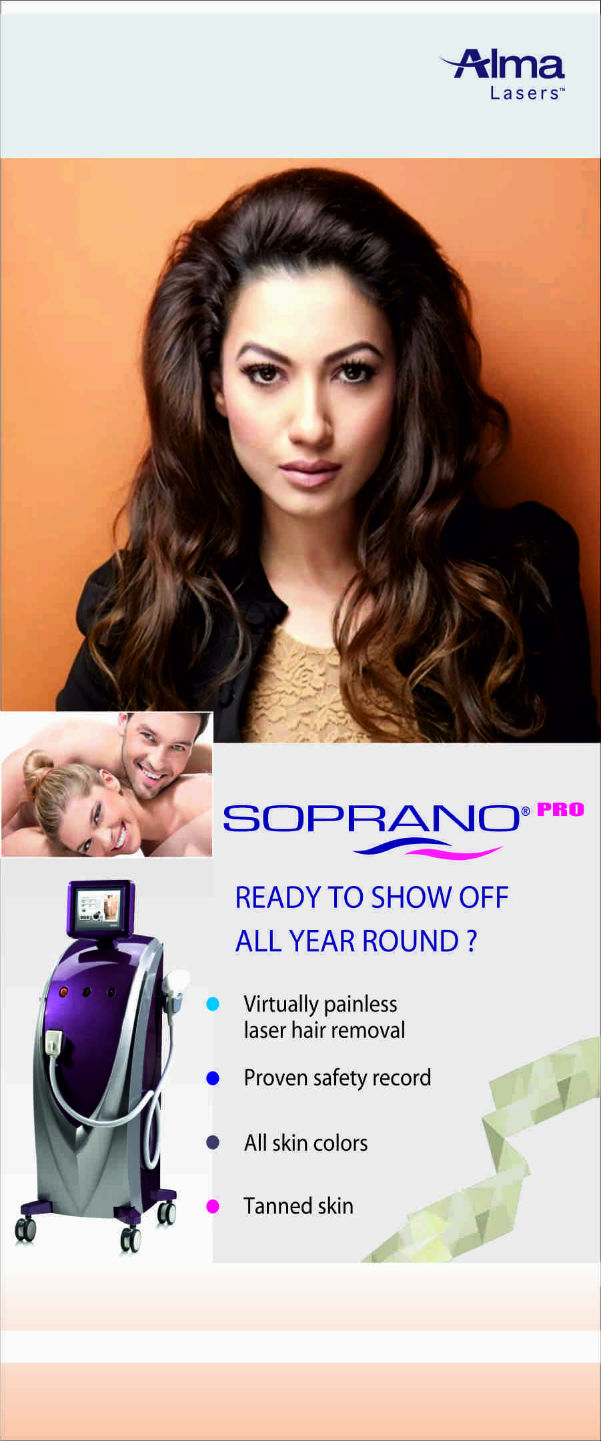
Dull Skin
Dull Skin is usually a manifestation of dehydrated skin , stress , hormonal issues and deficiency of vitamins .
Treatment
Microdermabrasion
Our clinic uses microdermabrasion to restore the skin’s healthy condition. Depending on your skin needs, it helps in rejuvenating your skin efficiently. Microdermabrasion is a non-invasive and painless treatment that uses tiny and rough grains or crystals to buff the surface layer of the skin. It provides deep and professional-strength exfoliation in removing deep-seated dead skin cells to encourage and stimulate the growth of new skin cells.
Vampire Facial
WHAT IS PRP?
Platelet rich plasma (PRP) is concentrated blood plasma that contains approximately 3 to 5 times the number of platelets found in normal circulating
blood. In addition, it contains platelet-derived growth factor (PDGF), vascular endothelial growth factor (VEGF), transforming growth factor (TGF) and
other bioactive proteins that help in the rejuvenation of skin.
PRP is a facial rejuvenation treatment that uses your own plasma to stimulate collagen production and cell migration, allowing for the elimination of lines, folds, and wrinkles. Results from PRP
therapy are natural looking and subtle, and they can last for as long as two years. What’s more, PRP is minimally invasive, has no risk of allergic reaction, and can be used to treat nearly any area
of the body without risks of side-effects, making it ideal for patients who are not interested in or are not good candidates for injectable fillers.
HOW DOES PRP REJUVENATE THE SKIN?
The body cells which aid the tissue in healing and producing new cells are called Platelets. PRP is injected into targeted areas of the skin and then forms an environment which helps in growing collagen, regenerates the tissues and makes your skin smooth and tight. PRP softens wrinkles and creates skin texture and tone that is smoother, younger and better.
HOW DOES PRP REJUVENATE THE SKIN?
While PRP treatment engineers the total facial rejuvenation, there are certain checks which are to be made during and after the treatment.
- Patient’s faces are to be iced once the treatment is done to prevent any bruises or burns inflicted at the areas where the injections have been implemented
- While any irritation or swelling is only temporary, icing helps in reducing the chances of such events.
- Those who have sensitive skin should have a session with the doctors to iron out any side effects before, during or after the treatment
- Sensitive or not, PRP treatment involves micro-needling procedures which can inflict swelling and may even cause infection. Hence, it is necessary to have ample breaks between the treatments to give sufficient self-healing time to skin
- Avoid taking any other pills/drugs without prescription for atleast 7-20 days post treatment and always keep your doctor informed about it
- Avoid doing any heavy work either at work or at home. It would be best to take a day off for a couple of days post treatment is done
PRP SKIN REJUVENATION TREATMENT PROCEDURE
The PRP treatment is a simple, safe procedure
- Blood is taken (just like any other blood test), and then spun in a centrifuge machine for around 8-10 minutes
- The whole procedure gets over in 20 minutes.
- The amount of blood taken from the body can be from 10ml to 30ml, based on the number of targeted areas to be treated.
- During the centrifugation process, the cells are separated the top layer of blood, fibrin, is extracted along with the rich platelets and re-injected into the targeted area.
EXPECTATIONS AFTER PRP TREATMENT PROCEDURE
Once the PRP treatment procedure is over, you can expect the following things to occur:
- Bit Swelling :One might face a bit of swelling on the treated area with a bit of redness. Swelling will occur for sure as the treatment involves reinjection of fluids.
- Temporary Bruises :Be prepared for bruises at the targeted areas but it will go away in a few days
- No Infectious Side Effects : There won’t be any infectious side effects as platelets are made from the patient’s body cells
- Advised to Avoid Heavy Work Load : One would be able to do the daily chorus, at work or home in a day or two. However, try to avoid any heavy work load for a couple of days
- Advised to Keep the Skin Hydrated :use ample moisturizers to protect your skin for long
RESULTS FOR PRP SKIN TREATMENT
It is ideal to undergo three treatments with a gap of four to six weeks in order to get the maximum output of PRP skin rejuvenation treatment. Post treatment, the first effect will appear in the first month when you will experience the improvement in the skin texture. Most of the collagen is reproduced in about 3 months after the treatment is finished. When that happens, one can experience youthfulness of skin which is amply lifted and has lesser wrinkles or lines. The effects of PRP treatment will stay up to a couple of years. However, it is suggested to visit your doctor at the end of year and discuss how the effects can be sustained for longer. Some people usually go for touch ups each year to keep their skin intact.
BENEFITS OF PRP SKIN REJUVENATION TREATMENT
- Non-Invasive : PRP is a non-surgical process. The platelet-rich plasma extracted from the patient’s blood sample is simply injected into the area to be treated with a small needle.
- Quick : Since it’s a non-invasive process, PRP treatments can sometimes take, as less as 30 minutes. Once the platelet-rich plasma is activated, it mimics an injury response in the body. Healing and growth factors work to remodel the epidermis and enhance the texture and appearance of the skin. As the body begins to produce natural collagen in the affected area, results are noticed within the first few weeks following the first treatment, and the skin’s appearance continues to improve over time.
- Long Lasting :The process is quick, but the result is just the opposite. For optimal results, three or four treatments may be recommended, after which the benefits will continue to be visible for up to 18 months or more.
- All Natural :Your body naturally produces the ingredients necessary to rejuvenate your skin. Every treatment is formulated using blood from the patient’s own body. This means there is no chance of allergic reaction, infection, or rejection of the treatment– the same can’t be said of synthetic fillers.
VAMPIRE FACELIFT VS PRP TREATMENT
A cosmetic procedure is available to patients who want to surgically reposition the facial tissues that have loosened over time. The Vampire Facelift uses injections of the patient’s own blood through a technology known as Selphyl. This procedure involves extracting blood from your arm and then spinning the blood sample in a centrifuge to separate the platelets. The blood cells are then re-injected into the skin with a very fine needle, and only injected into the areas that need to be filled out or restored. These injections are performed in conjunction with fat injections to create a smooth, rounder and plumper appearance. The term Vampire Facelift™ was trademarked by an Alabama-based physician, Dr. Charles Runnels. A Vampire Facelift™ is a combination treatment that incorporates PRP with the appropriate hyaluronic acid injectable fillers based on the patient’s specific needs to produce the most optimal results. The combination of hyaluronic acid fillers and PRP can address even deeper folds and wrinkles, producing a softer and significantly more youthful appearance that can last for 9-12 months. This option is often best for men and women who have more pronounced signs of aging due to smoking, excessive sun exposure, and other environmental and genetic factors.
Q switch laser /Hollywood Peel
What is a Hollywood Laser Peel?
The famous Hollywood peel helps to stimulate collagen, even out the skin tone and helps to reduce pigmentation. It is also called as carbon peel which helps to rejuvenate the appearance of aging and damaged skin. It leaves the skin looking radiant and glowing and is a painless treatment with no downtime. It received its name due to its popularity with the Hollywood A-listers before walking the red carpet.
How does Hollywood laser work?
The laser light works on the pigment cells and collagen cells.
- It targets the melanin (pigmentation) in the cells, breaking it up so they can be removed naturally by the body and hence doesn’t destroy the Melanocytes that reduces the chances of hypopigmentation.
- It also heats the deep dermis and causes the skin to contract and stimulates collagen which helps to improve the tone and texture.
Hence this leaves the skin free from any pigmentation giving a glow and youthful look.

Ageing Skin
Ageing of the skin is a gradual process that is associated with changes to the appearance, characteristics and function of the skin. A combination of genetic, lifestyle, dietary and environmental factors contribute to skin ageing.
Internal factors causing ageing
Intrinsic ageing, also known as the natural ageing process, is a continuous process that normally begins in our mid-20s. Within the skin, collagen production slows and elastin, the substance that enables skin to snap back into place, has a bit less spring. Dead skin cells do not shed as quickly and the turnover of new skin cells decreases between the ages of 20 and 60. While these changes usually begin in our 20s, the signs of intrinsic ageing are typically not visible for decades. Our genetic makeup controls how quickly the normal ageing process happens.
External factors causing ageing
A number of extrinsic or external factors can act individually or together on the normal ageing process to age our skin prematurely. Most premature skin ageing is caused by sun exposure. Other external factors that prematurely age our skin are repetitive facial expressions, gravity, sleeping positions, diet and smoking.
Treatment
Chemical Peels
Peels available at Skin Station
Alpha Hydroxy Acid Peels
Alpha hydroxy acids, also known as AHAs, are one of the most popular ingredients in a mild chemical peel. Glycolic acid is the most common AHA used for this purpose. AHA peels rarely need any sort of anesthetic to perform, and the discomfort during and after the procedure is minimal. This peel is typically used to reduce the appearance of fine lines, smooth rough skin and produce a more even skin tone. Because this is a mild chemical peel, a series of treatments may be required to achieve desired results.
Beta Hydroxy Acid Peels
The most common beta hydroxy acid used in chemical peels is salicylic acid. This substance is also frequently used in acne products, which is why salicylic chemical peels are often used to treat acne-prone skin. Salicylic acid is more potent than glycolic acid, so it provides a slightly deeper chemical peel with longer lasting results. Because beta hydroxy acid chemical peels are also considered mild resurfacing treatments, no anesthesia is needed and the recovery time after the procedure is relatively short. However, it may take more than one treatment session to achieve desired results, and the procedure will need to be repeated periodically to maintain softer, smoother skin.The most common beta hydroxy acid used in chemical peels is salicylic acid. This substance is also frequently used in acne products, which is why salicylic chemical peels are often used to treat acne-prone skin. Salicylic acid is more potent than glycolic acid, so it provides a slightly deeper chemical peel with longer lasting results. Because beta hydroxy acid chemical peels are also considered mild resurfacing treatments, no anesthesia is needed and the recovery time after the procedure is relatively short. However, it may take more than one treatment session to achieve desired results, and the procedure will need to be repeated periodically to maintain softer, smoother skin.
Jessner's Peel
Jessner's peel is actually a combination of ingredients mixed into a single formula. It is considered a light chemical peel that is slightly stronger than both the alpha and beta hydroxy formulas. Jessner's peel uses lactic acid, salicylic acid and resorcinol, which is also sometimes used as a disinfectant or acne medication. It is applied to skin that is too damaged to respond well to an AHA peel, but does not require a medium to deep treatment. Jessner's peels are often applied without the use of anesthetic and complete recovery after the treatment takes about a week.
TCA Peels
Trichloroacetic acid is the most common ingredient found in medium chemical peels. This substance can successfully treat a host of skin imperfections, including sun damage, fine lines and wrinkles, and acne scarring. The procedure offers effective results with minimum risk. Most patients do not require anesthesia during the procedure, although over the counter pain medications may be needed for a day or two afterward to reduce the stinging sensation that can sometimes occur. TCA chemical peels usually take about a week to recover from, and the results are much more dramatic than lighter peels can offer. Some patients need more than one treatment session to achieve desired results.
Dermal Fillers
Over time the amount of collagen in your skin diminishes causing skin to lose its volume. This is a perfectly normal part of the ageing process, but these lines and wrinkles can be unwelcome. Dermal fillers help to temporarily replenish the areas affected by loss of volume. The fillers contain hyaluronic acid which is naturally present in your skin. Hyaluronic acid has replaced older collagen based products as it has a shorter period of recovery, better results and considerably fewer adverse reactions. The London Dermatology Centre stocks a number of different dermal fillers, including Juvederm®, Restylane®, and Teosyal®. Your aesthetic physician will be able to advise on the product best suited to your needs and your skin type.
Botox®
Botox®, otherwise known as Botulinum Toxin, is the most popular anti-ageing treatment available. It is a naturally occurring protein derived from the bacterium Clostridium Botulinum. Wrinkles are caused by changes in the skin, around areas where muscles are overactive, for example, around the eyes and mouth. The Botulinum renders muscles temporarily inactive making the face appear softer, smoother and younger. The most commonly treated areas are frown lines on the forehead, Crow's feet around eyes, bunny lines on the bridge of the nose, horizontal necklace lines and vertical platysmal bands.
Hyperhydrosis Botox® Treatment
Botox® is proven to significantly reduce excessive and inappropriate underarm sweating, known medically as hyperhidrosis. Excessive sweating can be a troublesome problem for many and can limit an individual's social, professional and personal lives. Topical antiperspirants tend to mask the problem by blocking pores. These are often ineffective and can be potentially harmful. First, a local anaesthetic is applied to numb the area. Then, a fine needle is used to make 15 to 20 injections into each underarm. The results usually last between 4 to 8 months.
LASER TREATMENT
Fraxel is a treatment that uses fractional laser technology to treat minor to severe skin damage. The Fraxel laser is an effective treatment for scarring, sun spots, wrinkles and other signs of aging. The laser targets both the superficial and the deeper layers of the skin giving a smoother, fresher and more youthful appearance. It is an effective treatment for anywhere on the body. The Fraxel treatment is carried out by one of our highly trained specialists. During your initial consultation the specialist will discuss the procedure with you and come up with a personalised treatment plan. For the best results it is recommended that patients have 3 to 6 sessions of Fraxel treatment. Each Fraxel treatment will take between 20 to 30 minutes.
NATURAL SKIN REJUVENATION WITH PRP
This is one of the safest and non-invasive US FDA approved services that stimulate collagen production, thereby reducing the appearance of fine lines, sagging skin and also rejuvenate skin making it look youthful. In this service, your body's own plasma that is rich in platelets is used to naturally rejuvenate the skin. The blood platelets release 'growth factors' which help stimulate collagen production, diminishing the effects of aging on your skin. This service is natural and with no downtime.
HOW DOES PRP TREATMENT FOR SKIN REJUVENATION DIFFER FROM FILLERS OR OTHER INJECTION?
- Lines and skin folds are a common sight on the tired skin, especially around mouth area or plump lips. These are filled by the solid materials of Hyaluronic acid fillers, namely Restylane and Juvederm. These fillers can go on from 6-18 months and are to be redone after a certain period of time given by the doctor concerned.
- PRP enables the collagen grown by the body and stimulates it to engineer total facial rejuvenation instead of focusing on one wrinkle at a time. It is also used to stabilize the faces which look tired, aids in filling up hollowed cheeks, skin tone improvisation, making the skin tight and smooth, and fill in the skin areas which the hyaluronic acid either cannot fill either due to lack of reach or reactionary issues.
- PRP treatment for skin can be done in tandem with Hyaluronic fillers like Restylane and Juvederm. Theese are two kinds of treatments which complete each other in order to aid the patient in achieving a much younger face. What fillers cannot do is done by the PRP treatment, for e.g. Fillers helps in removing lines and folds and PRP focuses on volumizing the face and enhances the skin tone. PRP also improves the texture of the skin and makes it smooth
PDO
PDO or polydioxanone threads are specially designed threads used to lift, tighten and renew sagging skin. The PDO lift procedure is a non-surgical alternative to a facelift. The specialised PDO threads are used to lift and tighten sagging skin around the face and neck, and to stimulate the network of supportive collagen fibres within the skin. Special threads are placed carefully within the face to create a more youthful appearance without the need for surgery or extensive downtime. The results from the PDO threat lift are typically longer lasting than dermal fillers and botox. PDO thread lifting is a minimally invasive procedure that does not require general anaesthetic and has very little downtime. Polydioxanone (PDO) threads are made of the same material as dissolvable sutures used to close wounds. However, instead of taking two weeks to dissolve, they take around six to nine months. The PDO thread lift procedure takes around 30 minutes which is why it has come to be known as the lunch hour lift, the half hour face lift and the one stitch face lift. Following the application of some local anaesthetic, the specialised PDO threads are placed within the deeper layers of the skin and the skin is lifted. The treatment is safe and you can return to work the same day with minimal discomfort. As well as lifting, PDO threads can be used purely to stimulate collagen production in the skin and because of this, PDO threads work well in combination with other rejuvenating treatments.

HIFU
The ULTRAFORMER Ⅲ is a completely non-invasive, face lifting and tightening, body tightening and contouring device that provides a customized treatment procedure for the entire face, neck, and body.
The ULTRAFORMER III is an optimum, non-invasive ultrasound device that lifts and tightens the face for a youthful complexion and tightens the body for slimmer contours. With precision per shot pulse, HIFU-powered transducers are designed to either remodel collagen to remove facial wrinkles and sagging skin or tighten body tissues to reflect your true potential.
The ULTRAFORMER III treats fine lines, wrinkles, or hyperpigmentation on the face. It is also suitable for those who desire more curvaceous hip lines and slimmer contours.
What Can You Treat?
Engineered with endless capabilities offering endless combinations of treatment regimens, the ULTRAFORMER III is suitable for patients with the following concerns:
- LOOSE & SAGGING SKIN
- SKIN FOLDS
- FINE LINES & WRINKLES
- SIGNS OF AGING
- DECREASE IN SKIN ELASTICITY
- V-LINE CONTOURING
Sessions – one session recommended once in 9 months to 1 year
Alma Accent RF SKIN TIGHTENING
Alma Accent Xli is Alma Lasers most advanced workstation for skin tightening, body contouring and aesthetic enhancement. The treatment is almost painless and without downtime .
The platform combines the latest innovations in ultrasound (US) and radio frequency (RF) technologies to deliver effective, highly customized treatments with natural, long lasting results.
RF power is then used to produce thermal deep heating to the tissue, resulting in more concentrated energy treatment. This unique combination reduces treatment time and number of sessions while yielding more powerful results.
Focused Depth Control
Patented Alma Unipolar technology allows for focused, safe and deep heating of tissue at various depths within the skin. With variable depth control, practitioners have the flexibility and precision to treat the target area for optimal results.
Indications –
- Facial contouring and Non surgical Skin lifting
- Under eye fine lines
- Stretch marks
- Tummy tightening
- Arms tightening
Sessions – 6 -8 sessions at interval of 7 – 10 days

HYDRA FACIAL
Also known as Vortex-fusion technology
Mode of Action: The spiral eddy movement is combined with vacuum technology. Water molecules
directly penetrate to pores and continually make the Brownian movement. Unique Solutions are used in this step.
Benefits:
- Deep cleansing and removal of dead impurity
- Black and white head removal
- Skin brightening
- More radiant and supple skin
- Improved skin texture
- Enhances skin tone
- Skin rejuvenation
- Nourishing and hydrating skin
- Correction of fine lines and wrinkles
OxyGemeo
Also known as Oxygenation
Mode of Action: The particular CapsugemTM tip with a specific vibration frequency of handle produces countless CO2 microbubbles. The minute CO2 bubbles penetrate the skin & rupture to trigger the Bohr effect and hence oxygenate the skin surface.
Benefits: Oxygen content enrichment in blood, skin brightening, skin lightening & skin rejuvenation
Benefits –
- Skin brighteness and glow
- Deep cleansing and removal of dead impurity
- Black and white head removal
- Skin brightening
- More radiant and supple skin
- Improved skin texture
- Enhances skin tone
- Skin rejuvenation
- Nourishing and hydrating skin
- Correction of fine lines and wrinkles
KOREAN GLASS SKIN by DERMAPEN4
The latest Dermapen 4 TM is taking the microneedling pen industry by storm.
Dermapen 4 glides over the skin creating millions of fine, vertical fractional channels up to 104% faster than other microneedling pens. These channels can carry up to 80% more topical nutrients deeper into the skin.
The micro-injuries trigger a natural process of repair, increasing the production of collagen and elastin and visibly improving a wide range of skin concerns.
Dermapen technology has significant benefits over dermal-rolling and fractional laser treatments, due to the minimal trauma to your patient’s skin. Dermapen microneedling gives skin the chance to spend more efforts fighting the ailment itself, rather than any collateral damage caused by the procedure.
Maximum Results. Minimal Trauma.
- Anti-Ageing:Dermapen microneedling procedures boost the body’s natural healing response to increase collagen and elastin production for reduced wrinkles and lines.
- Pigmentation:Unlike some laser treatments, Dermapen microneedling removes the risk of heat injury and hypopigmentation risks, while promoting optimized cell function.”
- Enlarged Pores:Microneedling with Dermapen stimulates the skin to produce new collagen, plumping up and tightening the appearance of the enlarged pores.
- Scarring:Dermapen 4 is the only microneedling device with a dedicated scar setting and protocols for revision of all scar types including acne scarring.
- Stretch Marks:Many practitioners and patients have claimed that Dermapen Treatments™ have been more effective in treating stretch marks than other methods.
- Acne:Dermapen Treatments visibly improve the appearance of problematic skin breakouts and black or whiteheads (comedones) and active acne.

FRACTIONAL CO2 LASER (ENERGI)
Fractional CO2 laser is a type of skin treatment used by dermatologists or physicians to reduce the appearance of acne scars, deep wrinkles, and other skin irregularities. It is a non-invasive procedure that uses laser, specially made of carbon dioxide, to remove the outer layers of damaged skin.
Fractional CO2 laser is commonly used to treat acne scars. However, it can also tend to a wide range of skin problems such as:
- Age spots
- Crow’s feet
- Enlarged oil glands (especially around the nose)
- Fine lines and wrinkles
- Hyperpigmentation
- Sagging skin
- Sun damage
- Uneven skin tone
- Warts
Fractional CO2 laser is ideal for people who like to minimize the appearance of acne scarring, fine lines, pigmentation, and other skin conditions listed above. Dermatologists also recommend undergoing the procedure if you suffer from a non-responsive skin after a bad facelift.
Who Should Avoid Fractional CO2 Laser?
Unfortunately, the fractional CO2 laser is not for everyone. Individuals with extensive breakouts, open wounds, or any infections on the face are advised to stay away from this skin procedure. People who take oral isotretinoin should also avoid the procedure as it poses a risk for health and safety.
HAIR
GFC TREATMENT (Growth Factor Concentrate therapy)
Is also called the 4 th generation PRP
To get the most out of healthy hair, we also recommend the GFC hair treatment or Growth Factor Concentrate procedure. By using your own blood, the treatment uses a highly concentrated growth factor preparation that can be injected in the scalp and neck to promote hair growth.
The GFC treatment for hair relies on obtaining several growth factors from your blood. These include platelet-derived growth factors, epidermal growth factors, insulin-like growth factors and even vascular endothelial growth factors. To administer this procedure, your dermatologist will,
- Take around 16 ml of your blood.
- Take around 40-50 minutes to derive the growth factor and prepare the GFC treatment for hair.
- The final output will have 7-8 ml of GFC hair treatment that will be injectable.
The GFC treatment for hair has the following benefits,
- It helps with hair fall reduction, and makes hair thicker and fuller in volume.
- It is highly suitable for those who are in the initial stages of Alopecia.
- It is suitable for both men and women. The blood is taken out through a syringe and the growth factor is further examined to prepare the GFC treatment for hair without any contamination.
- The procedure doesn’t derive any added blood cells like the PRP treatment.
It is also essential to note that the GFC treatment for hair takes around 3-4 sessions to start showing results. It is also clubbed with other topical or oral medications to reduce pain and swelling. Any side effects usually get resolved within a week of the treatment session.
Directions for use
- Each Follirich GFC therapy kit is used for one patient in a single sitting.
- It is recommended to have three sittings for three months to get the best results.
- Results are associated with reduced hair fall and an increase in hair count and hair thickness.
- If needed, one sitting can be repeated before 4-6 months of the procedure, and the entire therapy can be repeated every year.
Advantages of Growth Factor Concentrate Therapy
GFC Therapy is the next-generation hair loss treatment that delivers one’s growth factors at higher concentrations.
- Highly effective and promotes natural and enhanced regeneration.
- Statistically significant increase in hair count and thickness guaranteed.
- 100% safe and prepared from the candidate’s blood.
- Zero RBCs and WBCs involved, which decreases pain and inflammation risk.
- Convenience and quality are guaranteed from the procedure.
- Less number of sessions are required to get optimum results.

Meet our Founder
We build strong connections with the ones who seek our assistance!
